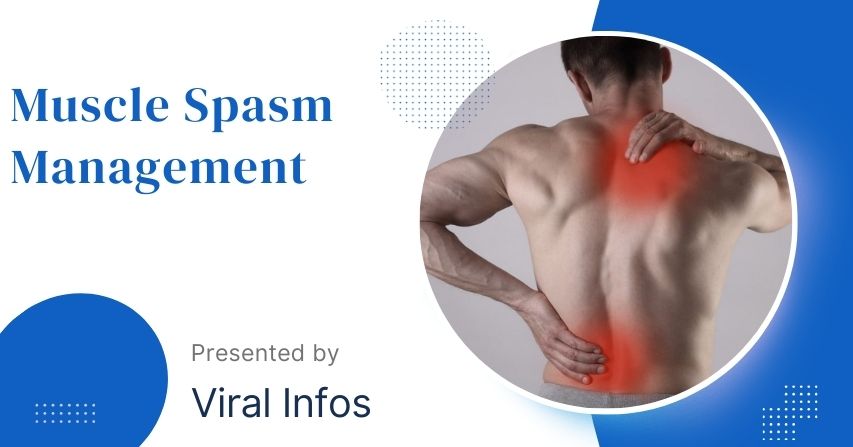Muscle spasm management is vital to help you feel better and get back to your normal activities. In the following sections, how to treat them when they happen, and how to prevent them in the future.
Muscle spasms are sudden and painful cramps that can happen when your muscles tighten up without warning. They can happen to anyone and are common in your legs, back, or arms. Muscle spasms can be uncomfortable and might stop you from doing the things you enjoy.
Muscle spasm management is vital to help you feel better and get back to your normal activities. In the following sections, we will discuss what causes muscle spasms, how to treat them when they happen, and how to prevent them in the future.
We will include easy steps to help you deal with muscle spasms so you can stay active and pain-free.
What are muscle spasms?
Muscle spasms, also known as muscle cramps, generally occur when your muscle tightens up on its own and can’t relax. This is normal and quite common. A muscle spasm can affect part of a muscle, the whole muscle, or even a group of muscles. You may get muscle spasms anywhere in your body. Here are a few of the most common types:
- Arm spasms
- Back spasms
- Abdominal cramps
- Chest cramps
- Neck spasms
- Rib Cage spasms
- Charley horses and leg cramps
Causes of muscle spasms
Muscle spasms are very common. They can happen in any part of the body, but they usually affect areas such as hands, thighs, arms, feet, abdomen, and intercostal muscles.
Muscle spasms are often caused by muscle pain, tiredness, and overuse. Stress or anxiety may also cause muscle spasms, especially in your face. Sometimes, trapped nerves can cause spasms in your back.
Muscle spasms can also occur in athletes who do not warm up or who engage in activities in extremely hot environments. For instance, the phrase “charley horse” is frequently used to characterize calf muscle spasms in runners. Not consuming enough water before physical activity, such as exercise, may cause muscle spasms.
Who is at risk for muscle spasms?
Muscle spasms can affect some people more than others. People who are most at risk include:
- People who are obese or overweight
- Older adults
- Pregnant women
- Athletes
- People over 65 years old
People with specific health problems, like nerve disorders or thyroid issues, often have muscle spasms more frequently than others. Muscle spasms are usually not severe, but sometimes, they can indicate a problem with the brain or spinal cord. These areas control muscle movement, so if there’s an issue, it might cause more muscle spasms.
Symptoms of muscle spasms
Muscle spasms can vary from mild to severe. In mild cases, it may feel like your muscle is moving or twitching on its own. Sometimes, you can even see your muscles twitching under your skin.
In more severe cases, your muscle might tighten up so much that it feels like a hard lump. This often happens with leg cramps. If a spasm is very painful, you might feel sore in that area for a day or two afterward.
Managing muscle spasms involves addressing their symptoms and causes. If spasms are related to nerve problems, you may also experience:
- Muscle weakness
- Muscle pain
- Numbness
- Paralysis
- Difficulty sleeping
- Vision issues
- Coordination issues
Treatment of muscle spasms
Treating muscle spasms involves several methods to help manage them. Effective muscle spasm management includes:
- Stretching the impacted part
- Massaging the affected part with a massage roller or hands
- Standing up and walking around
- Applying ice or heat
- Taking OTC painkillers like acetaminophen or ibuprofen
If your muscle spasms are severe or happen often, a healthcare expert might give you muscle relaxers to help reduce the symptoms. These medications can make you feel sleepy, dizzy, or nauseous. Because of these effects, they may not be the best option for long-term muscle spasm management. Talking to your healthcare expert about the pros and cons of using muscle relaxers to treat your spasms is essential.
Muscle spasm prevention
Muscle spasms can happen suddenly and unexpectedly. Because they are unpredictable, they can be hard to prevent. Some risk factors, like your age, cannot be changed. However, there are ways to reduce the chance of experiencing muscle spasms through effective management strategies.
- Engage in regular flexibility exercises to keep your muscles limber.
- Improve your overall fitness level with consistent workouts.
- Regularly stretch the muscles that are most prone to spasms.
- Make sure you drink plenty of water daily to keep your body hydrated.
- Avoid exercising in extremely hot conditions to prevent muscle spasms.
- Wear properly fitting shoes to support your feet and prevent cramps.
- Maintain a healthy weight to reduce stress on your muscles.
- Be cautious with medications that might cause muscle spasms as a side effect.
- To prevent leg cramps while sleeping, use pillows to elevate your feet or keep sheets and blankets loose around your legs.
When to consult a healthcare expert about muscle spasms
Muscle spasms, twitches, and cramps are usually not something to worry about. People who exercise often or play sports tend to have them more frequently. However, sometimes, they can indicate a health problem, such as multiple sclerosis, thyroid issues, or liver disease. They may also suggest issues with nutrition, nerves, circulation, hormones, and metabolism.
If you experience severe or painful muscle spasms on a daily basis, you must consult an experienced healthcare expert. They may suggest ways for proper muscle spasm management.
Expert tips and advice
Tips from healthcare experts or professionals are vital for muscle spasm management. Here are some tips and advice:
- Warm Baths: Taking a warm shower or bath can relax tight muscles and relieve spasms. Adding Epsom salts to your bathwater may also help.
- Limit Caffeine and Alcohol: Both caffeine and alcohol can dehydrate your body, which may increase the chance of muscle spasms. Therefore, you should limit your intake of these beverages.
- Wear Proper Footwear: Shoes that provide good support and cushioning may prevent muscle cramps in your feet and legs. Avoid wearing high heels for long periods.
- Listen to Your Body Signals: Pay attention to any warning signs your body gives you, such as muscle tightness or discomfort. Take breaks when needed and avoid overexertion.
- Use Compression: Compression garments or wraps around muscles prone to spasms can provide support and reduce the likelihood of spasms during physical activity.
Bottom Message
Understanding and managing muscle spasms can greatly improve your quality of life. Though often uncomfortable, muscle spasms are usually not severe and can be managed effectively with simple steps. You can lower the chance of experiencing muscle spasms by staying hydrated, stretching regularly, and maintaining a healthy lifestyle.
Listen to your body, especially if you have recurring or severe spasms, and seek proper guidance from a healthcare expert if needed. Remember, muscle spasms can occur for various reasons, from overuse to underlying health conditions, but with the right approach to muscle spasm management, you can stay active and pain-free.
By incorporating these muscle spasm management tips into your daily routine, you can help prevent this condition and enjoy life to the fullest.
Also read: Legendary Actor Donald Sutherland is No More












One thought on “Muscle Spasm Management: Step-to-Step Guide for Patients ”